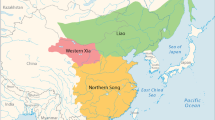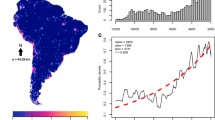Abstract
In our 2016 article in Scientific Reports, we advanced a new hypothesis for the Mongol withdrawal from Hungary in 1242 CE, based on a joint analysis of climatic, environmental, and historical data. The re-evaluation now offered by Pinke et al. casts doubt on this hypothesis. However, their arguments are based on a level of generality that fails to appreciate the specific conditions of the Mongol invasion, do not offer new or different climatic data, and are supported by anachronistic production data and environmental information, which cannot be related to the period in question. While we acknowledge the importance of an open debate, we stand by our conclusions.
Similar content being viewed by others

Introduction
Pinke et al.1 (P) argue against consideration of climatic factors in the 1242 CE sudden withdrawal of the Mongols from Hungary. While acknowledging their contribution to the long-lasting debate, we dispute each of their five key arguments1,2,3,4,5. Moreover, we re-emphasize the importance of multifaceted environmental aspects and the importance of annually resolved, absolutely dated and spatially explicit natural archives and historical sources2, when linking climate variability with human history3.
P contend that:
-
1).
a letter by King Bèla to the Pope (1250 CE) asserts that, had the Mongols attacked Hungary again, they could have settled there. This political document, however, bears no relation to the condition of Hungary in spring 1242. The Mongols might have settled in Hungary under normal conditions, and indeed preparations were made in 1241. Flooding and swamping, however, possibly hampered their military operations, and made the Mongols weary of settling.
-
2).
precipitation surplus favors agricultural production. We agree that this might be true in a steppe environment, but we need to consider the specific conditions of 13th-century Hungary. Climatic changes in the late 12th and early 13th century most likely raised the water level, while an overall high groundwater table contributed to the shrinkage of areas suitable for occupation and arable land4. Because of rising water levels in the 12th century, villages were often relocated to higher elevation5. From the 18th century onwards, agricultural productivity in Hungary was transformed due to extensive drainage, turning marshland into plough land6. Data used by P are for 1921–20107, and therefore anachronistic. P also confuse military capabilities with economic potential. On the contrary, we argue that wetter conditions hampered mobility of the Mongol cavalry, and thus critically contributed to their low success rate in 1242 and subsequent withdrawal.
-
3).
climate did not contribute to Hungary’s famine in 1243. Recent research, however, posited environmental impacts on the 1243 crisis8. Furthermore, Vadas9 attributes the famine of 1315–17 in Hungary to lower temperatures and flooding, which supports our contention that famines in the 13th and 14th centuries can be associated with flooding extremes and generally colder temperatures.
-
4).
most of the destruction occurred in the central Hungarian plain. Indeed, the Mongol invasion of 1241 was highly successful. However, in the following year, the Mongols met different conditions and had to withdraw; western Hungary thus came out largely unscathed. The different impact of the Mongol conquest in these two regions should take into account how different weather conditions affected military operations.
-
5).
a painting from Székesfehérvár provides useful insights. Nevertheless, the picture is anachronistic and does not illustrate conditions in spring 1242. That Székesfehérvár was surrounded by marshes “to inhibit the advance of a hostile army” actually supports our point that marshes would have hindered the Mongol army.
Finally, we have to stress the need for overcoming deterministic and reductionist tendencies, as well as for using truly cross-disciplinary approaches between natural sciences and the humanities when interpreting archaeological remains and historical events in the context of past climatic changes10,11.
Change history
10 May 2018
A correction to this article has been published and is linked from the HTML and PDF versions of this paper. The error has not been fixed in the paper.
References
Pinke, Z. et al. Climate of doubt: a re-evaluation of Büntgen and Di Cosmo’s environmental hypothesis for the Mongol withdrawal from Hungary, 1242 CE. Scientific Reports 7, doi:10.1038/s41598-017-12126-8, (2017).
Büntgen, U. & Di Cosmo, N. Climatic and environmental aspects of the Mongol withdrawal from Hungary in 1242 CE. Scientific Reports 6, 25606 (2016).
Büntgen, U. et al. Cooling and societal change during the Late Antique Little Ice Age from 536 to around 660 CE. Nature Geoscience 9, 231–236 (2016).
Mészáros, O. & Serlegi, G. The impact of environmental change on medieval settlement structure in Transdanubia. Acta Archaeologica 62, 199–219 (2011).
Vadas, A. & Rácz, L. Climatic Changes in the Carpathian Basin during the Middle Ages. The State of Research. Global Environment 6, 198–227 (2013).
Petrovszki, J. & Mészáros, J. The great Hungarian plain in the sheets of the Habsburg Military Surveys and some historical maps – A case study of the Körös/Criş drainage basin. Acta Geodaetica et Geophysica Hungarica 45, 56–63 (2010).
Pinke, Z. & Lövei, G. L. Increasing temperature cuts back crop yields in Hungary over the last 90 years. Global Change Biology doi:https://doi.org/10.1111/gcb.13808 (2017).
Kiss, A. Weather and Weather-Related Natural Hazards in Medieval Hungary II: Documentary evidence from the 13th Century. Medium Aevum Quotidianum 68, 5–46 (2014).
Vadas, A. Documentary evidence on weather conditions and a possible crisis in 1315–1317: Case study from the Carpathian Basin. Journal of Environmental Geography 2, 23–29 (2009).
Haldon, J. Cooling and societal change. Nature Geoscience 9, 191–192 (2016).
Büntgen, U. et al. Reply to ‘Limited Late Antique cooling’. Nature Geoscience 10, 243 (2017).
Author information
Authors and Affiliations
Corresponding authors
Ethics declarations
Competing Interests
The authors declare that they have no competing interests.
Additional information
Publisher's note: Springer Nature remains neutral with regard to jurisdictional claims in published maps and institutional affiliations.
Rights and permissions
Open Access This article is licensed under a Creative Commons Attribution 4.0 International License, which permits use, sharing, adaptation, distribution and reproduction in any medium or format, as long as you give appropriate credit to the original author(s) and the source, provide a link to the Creative Commons license, and indicate if changes were made. The images or other third party material in this article are included in the article’s Creative Commons license, unless indicated otherwise in a credit line to the material. If material is not included in the article’s Creative Commons license and your intended use is not permitted by statutory regulation or exceeds the permitted use, you will need to obtain permission directly from the copyright holder. To view a copy of this license, visit http://creativecommons.org/licenses/by/4.0/.
About this article
Cite this article
Büntgen, U., Cosmo, N.D. Reply to ‘Climate of doubt: a re-evaluation of Büntgen and Di Cosmo’s environmental hypothesis for the Mongol withdrawal from Hungary, 1242 CE’. Sci Rep 7, 12696 (2017). https://doi.org/10.1038/s41598-017-12126-8
Received:
Accepted:
Published:
DOI: https://doi.org/10.1038/s41598-017-12126-8
This article is cited by
Comments
By submitting a comment you agree to abide by our Terms and Community Guidelines. If you find something abusive or that does not comply with our terms or guidelines please flag it as inappropriate.


